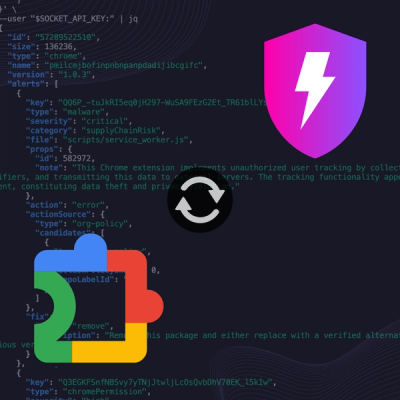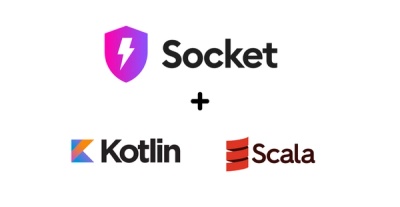
Product
Socket Now Protects the Chrome Extension Ecosystem
Socket is launching experimental protection for Chrome extensions, scanning for malware and risky permissions to prevent silent supply chain attacks.

Talkback is a javascript HTTP proxy that records and playbacks HTTP requests. As long as you have node.js in your environment, you can run talkback to record requests from applications written in any language/framework.
You can use it to accelerate your integration tests or run your application against a mocked server.
npm install talkback
Talkback is pretty easy to set up.
Define which host it will be proxying, which port it should listen to and where to find and save tapes.
When a request arrives to talkback, it will try to match it against a previously saved tape and quickly return the tape's response.
If no tape matches the request, it will forward it to the origin host, save the tape to disk for future uses and return the response.
const talkback = require("talkback");
//import talkback from "talkback/es6";
const opts = {
host: "https://api.myapp.com/foo",
record: talkback.Options.RecordMode.NEW,
port: 5544,
path: "./my-tapes"
};
const server = talkback(opts);
server.start(() => console.log("Talkback Started"));
Talkback can be used in 2 ways:
Returns an unstarted instance of a talkback server.
See all Options.
const talkback = talkback(options)
talkback.start(() => console.log("Talkback Started"))
talkback.close()
Returns a RequestHandler instance ready to receive requests.
See all Options.
The handler takes a request and returns a response Promise.
const talkbackHandler = await talkback.requestHandler(options)
const response = await talkbackHandler.handle(httpRequest)
| Name | Type | Description | Default |
|---|---|---|---|
| host | String | Where to proxy unknown requests | |
| port | String | Talkback port | 8080 |
| path | String | Path where to load and save tapes | ./tapes/ |
| https | Object | HTTPS server options | Defaults |
| httpClient | Object | Customize the options used in the HTTP call when proxying requests. More info | Defaults |
| record | String | Function | Set record mode. More info | RecordMode.NEW |
| fallbackMode | String | Function | Fallback mode for unknown requests when recording is disabled. More info | FallbackMode.NOT_FOUND |
| name | String | Server name | Defaults to host value |
| tapeNameGenerator | Function | Customize how a tape name is generated for new tapes. | null |
| allowHeaders | [String] | List of headers to include when matching tapes. If present, headers that are not part of the list will be ignored. By default, most headers are considered (See ignoreHeaders)Setting this value to [] will disable header matching on tapes.Note that content-type and content-encoding are needed to decode the body into plain-text. More info | null |
| ignoreHeaders | [String] | List of headers to ignore when matching tapes. By default, most headers are considered | ['content-length', 'host'] |
| ignoreQueryParams | [String] | List of query params to ignore when matching tapes. Useful when having dynamic query params like timestamps | [] |
| ignoreBody | Boolean | Should the request body be ignored when matching tapes | false |
| bodyMatcher | Function | Customize how a request's body is matched against saved tapes. More info | null |
| urlMatcher | Function | Customize how a request's URL is matched against saved tapes. More info | null |
| requestDecorator | Function | Modify requests before they are proxied. More info | null |
| responseDecorator | Function | Modify responses before they are returned. More info | null |
| tapeDecorator | Function | Modify tapes before they are stored. More info | null |
| latency | Number | \[Number\] | Function | Synthetic latency for requests (in ms). More info | 0 |
| errorRate | Number | Function | Probability between 0 and 100 of injecting a synthetic error. More info | 0 |
| silent | Boolean | Disable requests information console messages in the middle of requests | false |
| summary | Boolean | Enable exit summary of new and unused tapes at exit. More info | true |
| debug | Boolean | Enable verbose debug information | false |
| Name | Type | Description | Default |
|---|---|---|---|
| enabled | Boolean | Enables HTTPS server | false |
| keyPath | String | Path to the key file | null |
| certPath | String | Path to the cert file | null |
| Name | Type | Description | Default |
|---|---|---|---|
| fetchOptions | Object | Additional options passed to the fetch (node-fetch) call. List of supported options. | {} |
You can pass a custom agent to the fetch call, for example to use a proxy.
import { HttpsProxyAgent } from 'https-proxy-agent';
const agent = new HttpsProxyAgent('http://proxy.example.com:3128');
const talkbackOpts = {
...,
httpClient: {
fetchOptions: {
agent
}
},
}
Tapes are where talkback stores requests and their response.
path directory at startup. Since they are only loaded on startup, any changes to a tape requires a server restart to be applied.All tapes have the following 3 properties:
| Property | Type | Description | Example |
|---|---|---|---|
| createdAt | Date | Creation datetime of the tape | 2018-12-07T02:49:53.859Z |
| host | String | Base host url used for this request. Informative, it plays no role during the matching process | https://api.github.com |
| tag | String | Custom tag to identify the tape | auth |
| errorRate | Number | Number between 0 and 100 that marks the probability of the request producing a synthetic failure. More info | 10 |
| latency | Number | [Number] | Synthetic latency for requests (in ms). More info | 10 |
| reqUncompressed | Boolean | Whether the request body has been uncompressed | false |
| resUncompressed | Boolean | Whether the response body has been uncompressed | false |
| reqHumanReadable | Boolean | Whether the request body is in a human-readable format or base64 encoded | true |
| resHumanReadable | Boolean | Whether the response body is in a human-readable format or base64 encoded | true |
In addition to talkback properties, you can define their own custom fields either by manually editing the tape file or by dynamically adding them using a custom tape decorator.
| Property | Type | Description | Example |
|---|---|---|---|
| url | String | Url relative to the host. | /users |
| method | String | HTTP method | GET |
| headers | Object\<String, String\> | Request headers | {"content-type": "application/json", accept: "*/*"} |
| body | Buffer | Request body | Buffer.from("FOOBAR") |
| Property | Type | Description | Example |
|---|---|---|---|
| status | Number | HTTP response status code | 200 |
| headers | Object\<String, [String]\> | Response headers | {"content-type": ["application/json"]} |
| body | Buffer | Response body | Buffer.from("FOOBAR") |
Talkback will store the request and response body in plan text and uncompressed (human readable) if the content-encoding is supported (gzip, deflate, br) and the content-type is considered human readable (see list).
For this to work, both headers should be present in the request/response. Keep this in mind when setting the allowHeaders and ignoreHeaders options.
If the request or response have a JSON content-type, their body will be pretty printed as an object in the tape for easier readability.
This means differences in formatting are ignored when comparing tapes, and any special formatting in the response will be lost.
By default, new tapes will be created under the path directory with the name unnamed-[created_at_ms].json5 (unnamed-1715145165683.json5).
Tapes can be renamed at will, for example to give some meaning to the scenario the tape represents.
A custom tapeNameGenerator function can be provided to generate the file path (relative to path) at which to store the tape, using the tape's content.
Note that the file extension .json5 will be appended automatically.
function nameGenerator(tapeEpoch: number, tape: Tape) {
// organize in folders by request method
// e.g. tapes/GET/unnamed-1715145165683.json5
// tapes/GET/unnamed-1715145207909.json5
// tapes/POST/unnamed-1715145207946.json5
return path.join(`${tape.req.method}`, `unnamed-${tapeEpoch}`)
}
Talkback proxying and recording behavior can be controlled through the record and fallbackMode options.
There are 3 possible recording modes:
| Value | Description |
|---|---|
NEW | If no tape matches the request, proxy it and save the response to a tape |
OVERWRITE | Always proxy the request and save the response to a tape, overwriting any existing one |
DISABLED | If a matching tape exists, return it. Otherwise, don't proxy the request and use fallbackMode for the response |
The fallbackMode option lets you choose what to do when recording is DISABLED and an unknown request arrives.
There are 2 possible fallback modes:
| Value | Description |
|---|---|
NOT_FOUND | Log an error and return a 404 response |
PROXY | Proxy the request to host and return its response, but don't create a tape |
It is recommended to DISABLE recording when using talkback for test running. This way, there are no side effects and broken tests fail faster.
Both options accept either one of the possible modes to be used for all requests or a function that takes the request as a parameter and returns a valid mode.
const talkback = require("talkback")
const opts = {
record: talkback.Options.RecordMode.DISABLED,
fallbackMode: (req: Req) => {
if (req.url.includes("/mytest")) {
return talkback.Options.FallbackMode.PROXY
}
return talkback.Options.FallbackMode.NOT_FOUND
}
}
By default, in order for a request to match against a saved tape, both request and tape need to have the exact same body.
There might be cases where this rule is too strict (for example, if your body contains time dependent bits) but enabling ignoreBody is too lax.
Talkback lets you pass a custom matching function as the bodyMatcher option.
The function will receive a saved tape and the current request, and it has to return whether they should be considered a match on their body.
Body matching is the last step when matching a tape. In order for this function to be called, everything else about the request should match the tape too (url, method, headers).
The bodyMatcher is not called if tape and request bodies are already the same.
function bodyMatcher(tape: Tape, req: Req) {
if (tape.meta.tag === "fake-post") {
const tapeBody = JSON.parse(tape.req.body.toString());
const reqBody = JSON.parse(req.body.toString());
return tapeBody.username === reqBody.username;
}
return false;
}
In this case we are adding our own tag property to the saved tape meta object. This way, we are only using the custom matching logic on some specific requests, and can even have different logic for different categories of requests.
Note that both the tape's and the request's bodies are Buffer objects.
Similar to the bodyMatcher option, there's the urlMatcher option, which will let you customize how a request and a tape are matched on their URL.
function urlMatcher(tape: Tape, req: Req) {
if (tape.meta.tag === "user-info") {
// Match if URL is of type /users/{username}
return !!req.url.match(/\/users\/[a-zA-Z-0-9]+/);
}
return false;
}
Talback lets you tap into the request lifecycle through the decorator options:
When the request starts, talkback will create a MatchingContext object, which will be passed to all your decorators as an additional parameter.
It's the main way in which you can connect all your different decorator functions without having to modify the actual request/response.
The context will contain some useful properties, but you can also extend it with your own.
| Property | Type | Description | Example |
|---|---|---|---|
| id | String | Unique id (UUID v4) | 52a3cdf9-e3be-439f-b81d-4301b4f5adf0 |
By default, talkback will just proxy requests to the host as they are.
If you want to customize requests before they're proxied (or looked up in stored tapes) you can do so through the requestDecorator option.
requestDecorator takes a function that will receive the original request and the context object as parameters, and should return the modified request.
function requestDecorator(req: Req, context: MatchingContext) {
requestStartTime[context.id] = new Date().getTime()
delete req.headers['accept-encoding'];
return req;
}
In this example we are using the context's id to store the request's start time to later be used by another decorator.
If you want to add dynamism to the response coming from a matching existing tape or adjust the response that the proxied server returns, you can do so by using the responseDecorator option.
This can be useful for example if your response needs to contain an ID that gets sent on the request, or if your response has a time dependent field.
The function will receive a copy of the matching tape, the in-flight request object and the context object as parameters, and it should return the modified tape. Note that since you're receiving a copy of the matching tape, changes to the object won't persist between different requests.
Talkback will also update the Content-Length header if it was present in the original response.
We're going to hit an /auth endpoint, and update just the expiration field of the JSON response that was saved in the tape to be a day from now.
function responseDecorator(tape: Tape, req: Req, context: MatchingContext) {
if (tape.meta.tag === "auth") {
const tapeBody = JSON.parse(tape.res.body.toString())
const expiration = new Date()
expiration.setDate(expiration.getDate() + 1)
const expirationEpoch = Math.floor(expiration.getTime() / 1000)
tapeBody.expiration = expirationEpoch
const newBody = JSON.stringify(tapeBody)
tape.res.body = Buffer.from(newBody)
}
return tape
}
In this example we are making use of the meta.tag property on the saved tape to decide whether we apply the custom logic or not.
Note that both the tape's and the request's bodies are Buffer objects, and they should be kept as such.
Before saving the tape to disk talback can call your own tapeDecorator function where you can edit any of the tape's properties.
The function will receive the original tape and the context object as parameters, and it should return the tape to be stored.
You can use this to edit any of talkback's properties or add your own meta fields.
function tapeDecorator(tape: Tape, context: MatchingContext) {
if (tape.req.url.includes("/auth/")) {
tape.meta.tag = "auth"
}
const originalDurationMs = new Date().getTime() - requestStartTime[context.id]
tape.meta.originalDurationMs = originalDurationMs
tape.meta.latency = [Math.floor(0.5*originalDurationMs), Math.floor(1.5*originalDurationMs)]
return tape
}
In this example we are dynamically adding a tag based on the request URL.
We are also using the context's id to retrieve the initial request time which was saved by a custom requestDecorator and calculating how long did the request take. We store the original duration as a custom meta property, and we also set a range for the latency feature.
By default, talkback will try to reply to requests as fast as it can, but sometimes it's useful to understand how applications behave under real-world or even undesirably high response times.
Talkback lets you control response times both at a global or at a tape level.
The latency option will apply for all requests that match an existing tape or when using the PROXY fallback mode.
There are 3 possible types of values:
[min, max]: Requests will take a random number of milliseconds in the given range.(req) => latency: The function will be called for each request and it should return the desired number of milliseconds for the response time.At the same time, tapes can define their own specific response times by adding a latency property to the meta object.
This property accepts both numbers and ranges and will take precedence over the global latency option.
{
"meta": {
"createdAt": "2017-09-10T23:19:27.010Z",
"host": "http://localhost:8898",
"resHumanReadable": true,
"latency": [100, 500]
},
...
}
Similar to what the latency option does, you might want to test how your application behaves when downstream services start failing.
Talkback can aid here through the errorRate option, by returning synthetic 503 errors back to you application.
The errorRate option will apply for all requests that match an existing tape or when using the PROXY fallback mode.
There are 2 possible types of values:
(req) => errorRate: The function will be called for each request and it should return the desired probability of error for that specific request.At the same time, tapes can define their own specific error rates by adding an errorRate property to the meta object.
{
"meta": {
"createdAt": "2017-09-10T23:19:27.010Z",
"host": "http://localhost:8898",
"resHumanReadable": true,
"errorRate": 50
},
...
}
If you are using talkback for your test suite, you will probably have tons of different tapes after some time. It can be difficult to know if all of them are still required.
To help, when talkback exits, it will print a list of all the tapes that have NOT been used and a list of all the new tapes. If your test suite is green, you can safely delete anything that hasn't been used.
===== SUMMARY (My Server) =====
New tapes:
- unnamed-1715145207909.json5
Unused tapes:
- not-valid-request.json5
- user-profile.json5
This can be disabled with the summary option.
MIT
v4.2.0
FAQs
A node.js HTTP proxy that records and playbacks requests
The npm package talkback receives a total of 33,996 weekly downloads. As such, talkback popularity was classified as popular.
We found that talkback demonstrated a not healthy version release cadence and project activity because the last version was released a year ago. It has 0 open source maintainers collaborating on the project.
Did you know?

Socket for GitHub automatically highlights issues in each pull request and monitors the health of all your open source dependencies. Discover the contents of your packages and block harmful activity before you install or update your dependencies.

Product
Socket is launching experimental protection for Chrome extensions, scanning for malware and risky permissions to prevent silent supply chain attacks.

Product
Add secure dependency scanning to Claude Desktop with Socket MCP, a one-click extension that keeps your coding conversations safe from malicious packages.

Product
Socket now supports Scala and Kotlin, bringing AI-powered threat detection to JVM projects with easy manifest generation and fast, accurate scans.